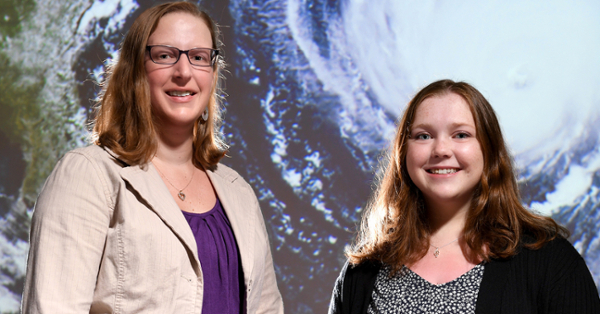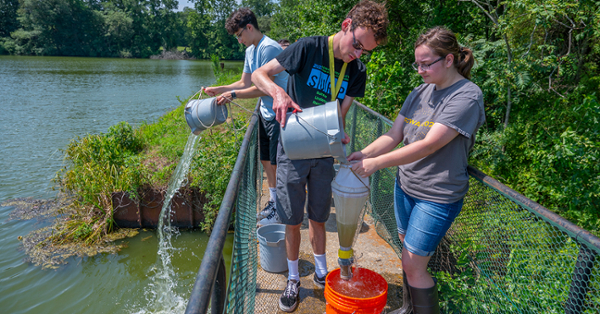At Rowan, summer means it’s time to study
At Rowan, summer means it’s time to study

Hundreds of Rowan University students are venturing outside the classroom this summer to immerse themselves in research activities.
Whether collecting samples in the field, conducting experiments in the lab, or analyzing data, enterprising undergraduates are gaining valuable research experiences through internships with Rowan faculty-researchers.
Along the way, interns are building resumes and typically earning either course credit or pay.
Algae blooms and biodiversity
Once a week, Jordyn Brown of Sicklerville treks to reservoirs along the Salem River to collect water samples for research using zooplankton, tiny creatures drifting along at the bottom of the food chain. By tracking their population changes, alongside other data, researchers hope to glean a better understanding of how algae blooms impact the health of a particular ecosystem. 
A biological sciences major in the College of Science & Mathematics, Brown joined the Ecological Diversity Group (EDGe) Lab last summer, where she and her fellow interns learned how to identify 40 types of zooplankton with guidance from Drs. Michael Grove, Courtney Richmond and Nathan Ruhl.
It’s a tricky task, since the distinguishing features of microscopic zooplankton aren’t always easy to see. Some slides might contain only 50 individuals; others contain well more than a thousand.
“With a lot of experience and practice, it gets a lot easier,” said Brown, a rising junior who is interested in pursuing a career involving environmental and ecological research. Working in the lab has also helped her make social connections with other students who share her interests.
“It’s definitely a new experience,” Brown said. “I think overall it just really helps me in a variety of ways.”
Predicting future hurricane trends
Mackenzie Weaver, an environmental science major in the School of Earth & Environment, is working with Dr. Andra Garner to predict hurricane trends on the East Coast. Using her laptop from her Williamstown home, she is analyzing data from models that consider a range of environmental variables to more accurately predict weather patterns.
Weaver chose Rowan largely for the hands-on research opportunities afforded to undergraduates. As a co-investigator with Garner, she will submit results of her hurricane research for journal consideration in July.
“This work is important because hurricanes are one of the most damaging environmental hazards we have on the Eastern Seaboard,” Weaver said. “And what the research shows is they will get more intense. Understanding those changes as much as we can will enable us to better prepare to handle these storms in the future.”
Building a better blueberry counter
Computer science major Harper Zappone works mostly from the comfort of her dorm, but is visiting a Hammonton farm twice this summer to count blueberries by hand. The field trips are necessary to test the accuracy of a computer algorithm under development by Professor Hieu D. Nguyen and interns in Rowan’s Department of Mathematics.
“More information and data is better for our models,” Zappone said, a rising sophomore. “It’s how they are trained. They chug as much information as you can give them.”
Machine learning could help farmers count blueberries, track which are ripe and perhaps detect disease, said Zappone. She loves the work.
“You feel like the work you’re doing is working toward a purpose,” Zappone said. “It’s changed my future outlook quite a bit.”
Gaining lab experience
Vincent Ferraro, a physics major, is testing new ways to enhance nuclear magnetic resonance signals with Dr. Nicholas Whiting in the Department of Physics & Astronomy.
By improving the signals, they hope to shorten the amount of time for patients to get an MRI from 30 to 40 minutes to perhaps just seconds. Ferraro has already gained lab experience that will help him in the classroom next fall, even if experiments fail.
“I enjoy it,” Ferraro said. “It’s just that it’s a lot of trial and error.”
Lina Russo, a biochemistry major, is gaining course credit this summer by working alongside Dr. Timothy Vaden in the Department of Chemistry & Biochemistry. They are investigating amino acid-based ionic liquids as biomaterials, focusing on how they affect protein unfolding.
“I want to work in research, probably something very similar to what I’m doing in Dr. Vaden’s lab,” Russo said. “I’ve learned how to use a lot of machinery that I wouldn’t normally have the opportunity to use. It’s widely applicable to other fields and improves my job prospects.”
Analyzing air quality changes during pandemic lockdown
Corrine Parisi, a civil engineering major working toward her second undergraduate degree, is interning with the Center for Research & Education in Advanced Transportation Engineering Systems this summer. With guidance from Dr. Kauser Jahan in the Henry M. Rowan College of Engineering, Parisi is analyzing studies on air pollution conducted during pandemic lockdown periods in cities around the world.
“Now that things have returned to normal, air quality trends have gone back to what they were before,” said Parisi. By examining the findings of these studies, the research team hopes to learn something new.
“That’s what these experiences are for—it’s for learning and growing and challenging yourself,” said Parisi, who recently left a full-time job in New York City to pursue engineering. “I’ve never done anything like this. I’m really glad I took on this challenge.”